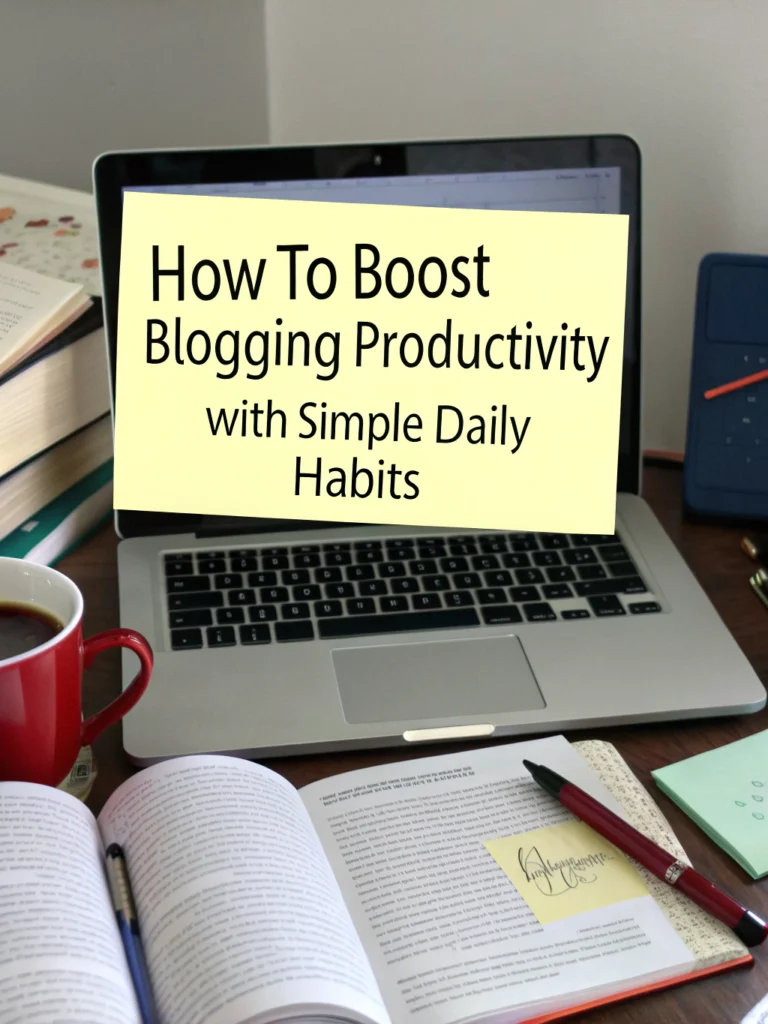How to Boost Blogging Productivity with Simple Daily Habits
Blogging productivity starts with consistent daily habits that transform your content creation process from chaotic to streamlined. If you've been struggling to publish regularly or feeling overwhelmed by your blogging workload, you're not alone. I've been there too.
After years of testing different approaches, I've discovered that the most successful bloggers don't rely on motivation or inspiration – they build systems that make productivity inevitable.
Why Most Bloggers Struggle with Productivity
The harsh truth? Most bloggers fail because they can't maintain consistent output. The problem isn't lack of ideas or talent – it's poor time management for bloggers.
Common productivity killers include:
- Perfectionism (endlessly editing instead of publishing)
- Distractions (social media, email notifications)
- Lack of structure (no clear publishing schedule)
- Burnout (trying to do everything at once)
But with the right daily habits, you can overcome these obstacles and dramatically increase your output without sacrificing quality.
Morning Rituals That Set You Up for Blogging Success
The way you start your day dramatically impacts your blogging productivity. Instead of immediately checking social media or email, implement these morning power habits:
- Idea capture: Spend 10 minutes brain-dumping content ideas before the mental noise of the day begins
- Content calendar check: Review what needs to be written today (not what you "feel like" writing)
- Prepare your environment: Clear your desk, close unnecessary browser tabs, and set up your writing tools
These rituals create the mental clarity needed for focused writing. For more ideas on creating the perfect productive environment, check out our guide on desk productivity tools to organize your workspace.

Time-Blocking: The Secret Weapon of Productive Bloggers
One of the most powerful productivity hacks for bloggers is time-blocking – scheduling specific chunks of time for different blogging tasks.
Here's how to implement it:
- Break down your blogging process into distinct activities (research, writing, editing, promotion)
- Assign specific time blocks for each activity
- Work on only ONE type of task during each block
- Use a timer to stay focused (25-minute Pomodoro sessions work great)
For example, my personal schedule includes:
- 9:00-10:30 AM: Draft new content
- 11:00-12:00 PM: Edit previous drafts
- 2:00-3:00 PM: Research/outlines for future posts
- 4:00-5:00 PM: Content promotion
This approach prevents the productivity-killing habit of multitasking. Need help tracking your time? Explore these smart productivity timer options to boost efficiency.
Content Batching: Multiply Your Output
Want to dramatically boost blogging efficiency? Stop creating posts one at a time.
Content batching is the process of grouping similar tasks together and doing them in concentrated bursts. Here's how to apply it:
- Research day: Gather resources for multiple posts at once
- Outline day: Create structures for 3-5 upcoming posts
- Writing day: Focus solely on drafting content
- Editing day: Polish multiple posts simultaneously
- Image creation day: Design visuals for several posts
This approach leverages the power of deep work and mental momentum. When you stay in one mode (researcher, writer, editor), you eliminate the productivity cost of context-switching.
For help organizing these batches, consider using productivity templates as outlined in our productivity templates for work success guide.
The Power of Content Templates
I've discovered that one of the most valuable content creation tips is developing templates for different post types.
For example, if you frequently write product reviews, create a standard structure with sections for:
- Introduction
- Product overview
- Key features
- Pros/cons
- Comparison with alternatives
- Final verdict
Templates eliminate decision fatigue and provide a clear path to follow when writing. They don't limit creativity – they channel it by removing unnecessary cognitive load.
Want to supercharge your template strategy? The >AI for Productivity eBook + Checklist: Supercharge Your Efficiency in 2135 offers cutting-edge tools for creating AI-enhanced templates that can cut your content creation time in half.
Minimize Distractions with Tech Boundaries
To improve blog writing routine, you must protect your attention fiercely. Digital distractions are the number one killer of blogging productivity.
Implement these tech boundaries:
- Use website blockers during writing sessions (Freedom, Cold Turkey)
- Put your phone in another room
- Turn off all notifications
- Close email and messaging apps
- Use minimalist writing tools (like IA Writer or Notion in focus mode)
Many successful bloggers also use the "airplane mode method" – working with all connectivity disabled for designated time blocks.
For more focus-enhancing strategies, especially if you struggle with attention challenges, check out the >ADHD Productivity Power Pack: Ebooks, Guides, Checklists, Workbook & Tools to Master Focus, Time Management & Organization.
The "Ugly First Draft" Method
One game-changing daily blogging habit is embracing the concept of the "ugly first draft." This approach separates creating from editing, dramatically increasing output.
The rules are simple:
- Write as quickly as possible
- Ignore spelling, grammar, and formatting
- Don't stop to research minor details (use [TK] as a placeholder)
- Don't edit while writing
- Set a timer and don't stop until it rings
Your first draft should be embarrassingly bad – that's the point! You'll fix it later during your dedicated editing time. This psychological trick removes the perfectionism that prevents many bloggers from ever hitting publish.
For more on overcoming writer's block and procrastination, visit our guide on productivity and procrastination tips and tricks.
Energy Management vs. Time Management
Traditional time management for bloggers focuses on squeezing more work into each hour. But what if the secret isn't more time but more energy?
Monitor when you naturally have the most mental clarity and creative energy, then protect those hours for writing. For most people, this is earlier in the day before decision fatigue sets in.
Schedule your blogging activities according to energy requirements:
- High energy: Writing new content, brainstorming ideas
- Medium energy: Editing, outlining
- Low energy: Administrative tasks, basic research, image selection
This energy-based approach ensures you're working with your natural rhythms rather than against them. Learn more about this approach in our comprehensive energy management for productivity tips.
Measure What Matters: Weekly Review Ritual
To continuously boost blogging efficiency, implement a weekly review process that tracks meaningful metrics:
- Words written
- Posts published
- Time spent in focused writing
- Most productive time of day
- Most effective writing environment
This data-driven approach helps you identify patterns and optimize your personal productivity system over time.
Don't fall into the trap of tracking vanity metrics like social shares or comments – focus on the production metrics you can directly control.
Conclusion: Consistency Beats Inspiration
The secret to blogging productivity isn't working harder – it's working smarter through consistent daily habits that compound over time.
By implementing morning rituals, time-blocking, content batching, templates, tech boundaries, and embracing imperfect first drafts, you'll transform your blogging practice from occasional inspiration to reliable production.
Remember that systems beat willpower every time. Build these habits into your routine, and watch your blogging output multiply while your stress decreases.
What daily habit will you implement first to boost your blogging productivity? The choice is yours, but the time to start is now.
FAQs About Blogging Productivity
How many hours per day should I spend writing blog posts?
Quality typically matters more than quantity. Most professional bloggers aim for 2-4 hours of focused writing time daily. The key is consistency – writing for 2 hours every day is far more productive than occasional 10-hour marathons.
What's the ideal length for blog posts in 2025?
The ideal post length varies by niche and topic. Data shows that comprehensive posts (1,500+ words) typically perform better in search results, but shorter posts (800-1,200 words) may be more appropriate for certain topics. Focus on thoroughly covering your topic rather than hitting a specific word count.
How can I create content faster without sacrificing quality?
Content templates, batching similar tasks, and separating writing from editing are the three most effective strategies. Also consider using AI tools for research and outlining, while keeping your unique voice and insights in the actual content.
I have ADHD – how can I maintain blogging productivity?
Structure becomes even more important with attention challenges. Consider using shorter work intervals (15-20 minutes instead of 25), more frequent breaks, and external accountability (writing partners or coaches). The >ADHD Productivity Power Pack offers specialized tools designed specifically for these challenges.
How do I know if my blogging productivity system is working?
Track your output metrics weekly (words written, posts published) and compare month-over-month. A good system should show steady improvement in output while maintaining or reducing your stress levels. If you're publishing more consistently without burning out, your system is working.

